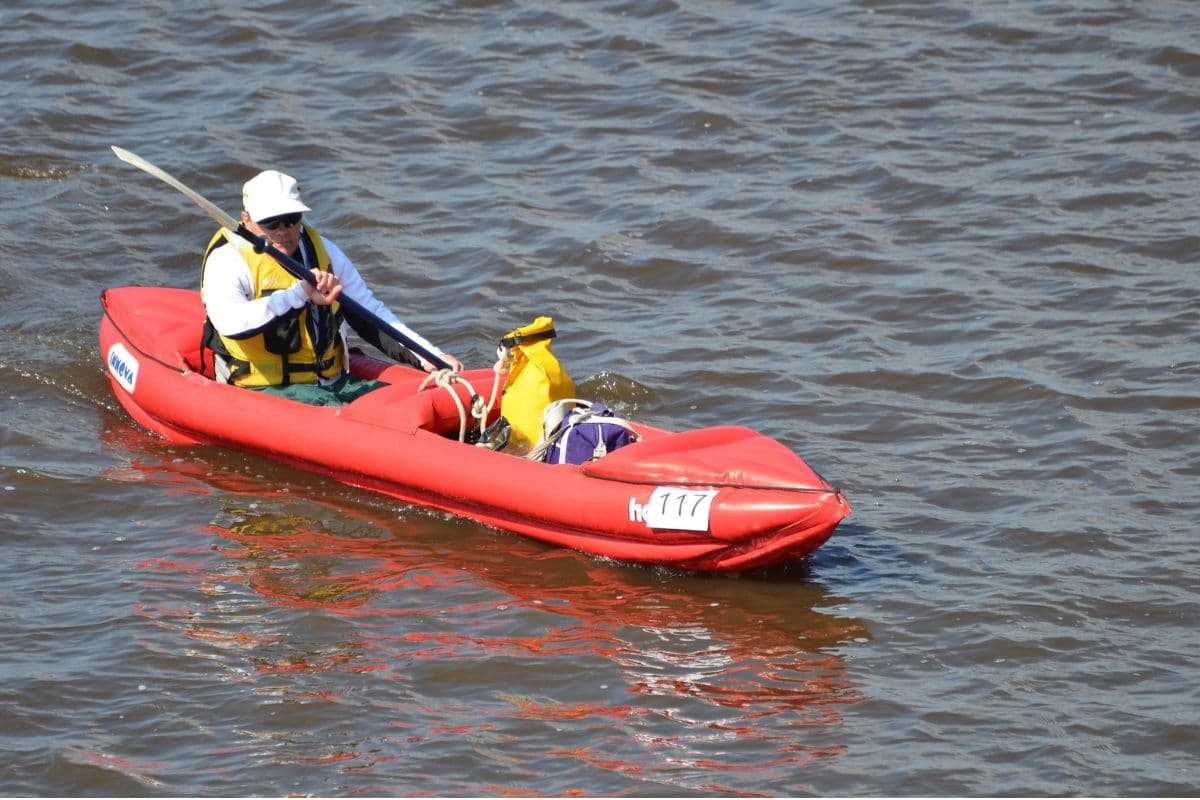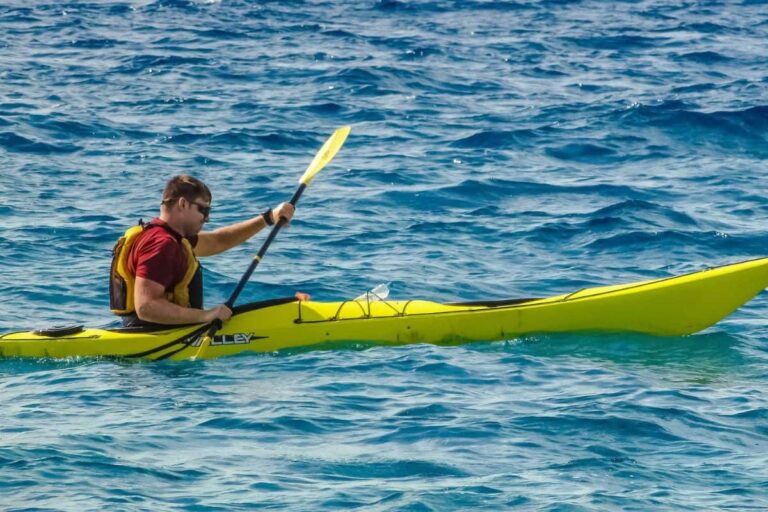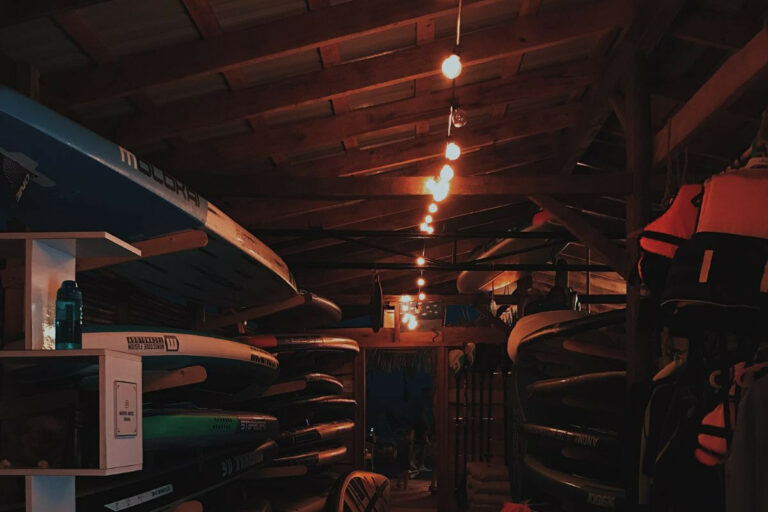Are Inflatable Kayaks Safe? (Pros & Cons)
Some people may hear the term “inflatable kayak” and immediately think of an oversized pool toy. But are inflatable kayak safety features on par with hard-shelled kayaks? Absolutely!
In fact, inflatable kayaks (which are cheaper alternatives to hard-shelled kayaks) may actually have a higher safety rating than their harder cousins in a few categories. They have many benefits that make them worth purchasing, but there are also a few downsides that must be considered as well.
You can find many videos on YouTube that demonstrate the inflatable kayak “torture test”, which involves putting the boats through a variety of outrageous tests to see what it takes to puncture them.
Finding out about the safety of inflatable kayaks is important because you don’t want to paddle out on the water and find yourself in a dangerous situation. Here’s what you need to know about inflatable kayaks before you make a purchasing decision.
What Is An Inflatable Kayak?

An inflatable kayak is precisely what its name implies: it’s an inflatable watercraft in the shape of a kayak. These boats consist of three air chambers, including the floor and two side chambers.
These chambers get filled up with air and keep your kayak afloat on the water. They can typically adapt to various types of pumps, including a foot pump, hand pump, or electric pump.
So why would anybody choose this type of kayak?
When a quality hard-shelled kayak costs double the price of an inflatable kayak, is it any wonder that many manufacturers sell out of the inflatable models so quickly? They provide a more than reasonable boating option for those who want a more affordable model.
Additionally, inflatable kayaks are easier to store and transport. Just think about it: rather than having to carve out a dedicated space that accommodates the size and shape of your kayak for storage, you can simply deflate an inflatable one and store it in a much smaller spot.
The same benefit is true in terms of transporting your kayak. Rather than having to tie a big hard-shelled kayak to the top of your vehicle, you can simply deflate this type of kayak and put it in your trunk.
What Are The Pros And Cons Of Inflatable Kayaks?
Advantages Of Inflatable Kayaks
1. Lightweight Design
A solo inflatable kayak weighs somewhere between 8 and 40 pounds, whereas a regular hard-shelled kayak can weigh anywhere from 40 to 70 pounds.
With similar tandem weight differences (35-65 pounds for an inflatable, and 60-90 pounds for hard-shelled), the inflatable kayak’s lightweight nature makes it a good choice for those who are looking for a lighter boat.
2. Smaller Size
While a fully-inflated kayak will be the same size as most hard-shelled models, it can be easily deflated to take up much less space.
When properly folded, an inflatable boat that would generally be 12 feet long may shrink down to just two square feet, saving you lots of room for storage.
3. Surprisingly Stable
While you’d think an air leak or single puncture hole caused by a sharp object would cause your inflatable kayak to sink immediately, that isn’t the case.
These kayaks have multiple air chambers that make them incredibly buoyant and able to sustain a bit of damage, and also keep them stable enough to withstand relatively rough conditions on the water.
4. Drop-stitch Design
Many inflatable kayaks have drop-stitch construction that allows for high inflation pressure.
This amount of pressure increases the stability and rigidity of the kayak.
5. Durable Beyond Expectations
Most modern inflatable kayaks have been designed with incredibly durable, surprisingly strong exteriors.
With proper maintenance, you can put your inflatable kayak through incredible rigors, wear and tear, without having it suffer extensive damage.
Disadvantages Of Inflatable Kayaks
1. Weaker Performance
Even though inflatable kayaks have come a long way, especially in recent years, they’re simply not as fast as hard-shelled kayaks.
They’re not intended to be used for racing, but they do make a good alternative for amateur paddlers who are looking for a simple recreational boat.
2. Launch Time
You’ll typically need to spend anywhere from a few minutes to up to 10 minutes inflating and preparing your inflatable kayak before it’s ready for use.
Similarly, it’s also advisable to spend time drying and deflating your boat after you take it out on the water.
This longer launch and removal time is something to consider before making your selection.
3. Susceptible to Wind
Hard-shelled kayaks are typically more robust and stable against wind and waves than their inflatable counterparts.
While some people may choose to take inflatable boats whitewater or sea kayaking, even inflatable whitewater kayaks are just not able to perform as well as hard-shelled ones.
Are Inflatable Kayaks Safe?

Quick answer: Yes, inflatable kayaks are very safe in a variety of situations. And typically, the higher-priced models are even safer than lower-cost ones.
Keep in mind that the more economical models usually don’t have the same kind of puncture protection you’ll get from higher-cost options.
They also don’t have the same level of overall stability and strength. Still, your average, moderately-priced inflatable kayak will still be safe in most situations.
In fact, there are some cases in which inflatable kayaks are safer than hard-shelled options for first-time boasters.
How is this possible?
Inflatable kayaks are broader than traditional kayaks, sometimes by as much as several inches.
This extra width, combined with the inflatable tubes and chambers on a quality inflatable kayak, typically provide more stability than a hard-shelled kayak, making it easier to keep the boat afloat and less likely to flip when you’re out on the water.
Surprisingly, many high-quality inflatable kayaks also react better to whitewater rapids, rocks, and other debris than hard-shelled options.
For example, an inflatable kayak is likely to bounce off stones or other sharp objects in a river bed that would potentially puncture the hull of most kayaks.
Of course, any time you are out on the water on any type of boat, including an inflatable kayak, it’s essential to always wear a life jacket.
Wearing a life vest also offers the extra peace of mind you need to fully enjoy your outdoor adventure.
With that said, you may not see many experts or seasoned kayakers putting their hard-shelled boats away. Why is that the case?
If Inflatable Kayaks Are Safe, Why Don’t Pros Use Them?
Yes, inflatable kayaks are safe and they do surprisingly well in rough waters (even whitewater rapids). But professionals still tend to choose hard-shelled boats for several reasons.
First of all, inflatable kayaks may be too light, which can cause them to flip in certain rough water conditions.
Secondly, professionals don’t trust them as much as hard-shelled kayaks in life-and-death types of situations, mainly since inflatable kayaks are slower and harder to keep straight.
This issue is a genuine problem for inflatable kayaks, because their lightness makes them move from side to side as you paddle.
While you will move forward, you won’t stay completely straight.
For serious kayakers, this situation can be frustrating, especially when they’re trying to stay straight in a tight race.
It can also be potentially dangerous if they end up flipping.
The likelihood of these issues occurring does decrease when you buy a higher quality inflatable kayak.
Options for inflatable kayaks can be broken down into three categories:
1) ones that are incredibly cheap and less durable
2) those that are safer and more durable
3) the type that are the strongest and best performing.
The third category of kayaks is still not quite at the same level as the hard-shelled option, but it is the best choice for those who are looking for the best quality inflatable boat.
Are Inflatable Kayaks Durable?
Yes. Inflatable kayaks are constructed with multiple layers of thickly coated materials, usually including a reasonably rigid PVC material, that make them surprisingly durable in a variety of situations. Also, their multi-chamber design helps to minimize the risk of sinking, even after several punctures.
What Size Inflatable Kayak Should I Get?

Most of the same things we covered in our kayak sizing guide apply to inflatable kayaks as well.
The size options aren’t significantly different from hard-shelled kayaks, so comparable sizes are available.
In addition, there are various types of inflatable kayaks.
For example, an inflatable fishing kayak tends to be wider to provide more stability.
You may find it easier to purchase an inflatable kayak designed for one person, even if you typically like to use a tandem kayak.
The tipping point will be different for an inflatable boat, and sometimes this can be difficult to navigate with two people.
Can I Use Inflatable Kayaks In Rough Water?
Inflatable kayaks are very safe in rough water conditions.
An inflatable kayak that is short and stout is better for rough water and river kayaking, while the longer ones are better for the flat waters of lakes or oceans.
Where Can I Find An Inflatable Kayak?
Most sporting goods stores that sell kayaks should also have inflatable models.
You can also find them online on sites like Amazon or specialty kayak online outlets.
What Do I Do If I Get A Leak?
If one of the chambers of your kayak were to tear open, causing air to leak out, the other chambers would continue to keep the boat afloat.
Rest assured, you will not see your inflatable kayak sink due to one hole or puncture.
Once you get back home, spread soapy water over your inflatable kayak and look for bubbles to help you spot the leak.
Put some waterproof glue over the hole or use a patch intended for this purpose.
You can buy a repair kit that comes with everything you need to get your kayak working again as good as new.
You can even purchase a small patch kit to take with you on your kayaking adventures for quick fixes.
Which Type Of Pump Should I Use For My Inflatable Kayak?
A hand pump is an excellent and inexpensive option, but it will likely take 15 minutes or more to inflate your kayak.
If you choose to use a hand pump, one of the most important safety precautions is to take your time and complete the process fully because an under-inflated kayak will be harder to paddle, and will not stay afloat as well.
Foot pumps are more expensive but faster. Electrical models are also fast, but may over-inflate the boat.
How Long Will My Kayak Last?
Most inflatable kayaks made with modern and sturdy materials should last for a long time if you treat them well and only expose them to normal wear and tear. Some people may get a decade or more out of these boats by adequately caring for both minor and significant damage.
Are You Considering Purchasing A Kayak?
Our answers to the question “Are inflatable kayaks safe?” should provide you with the necessary information you need to make the right purchasing decision.
In general, we’d say that they are an excellent option for many people, and can provide a great advantage in various types of kayaking situations.
And since inflatable kayaks are so relatively cheap compared to hard-shelled models, they may be an attractive choice.
Conclusion
If you’re in the market for a kayak, don’t dismiss the option of inflatable kayaks due to a perceived lack of safety. In reality, they’re actually one of the safest types of kayaks on the market for the average kayaker.
Table of Contents






